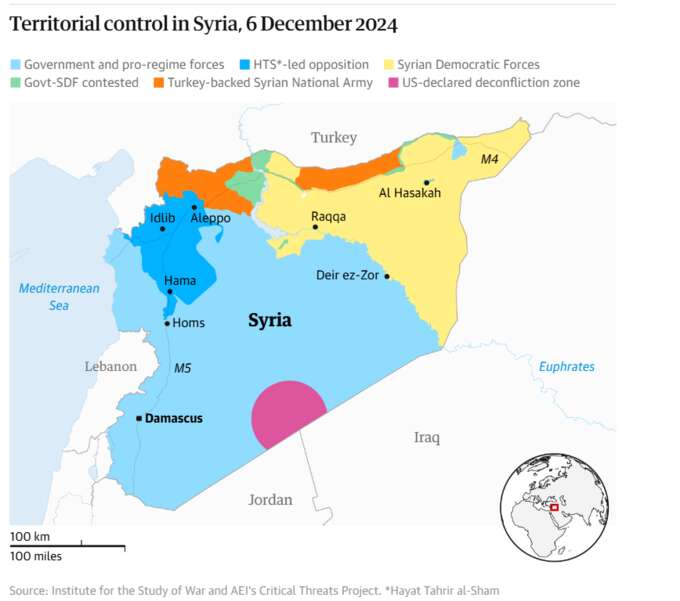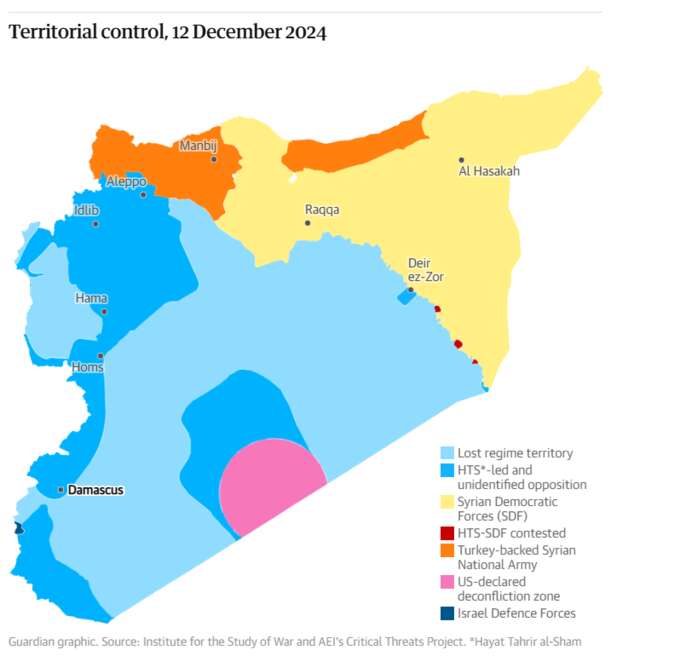Syrian rebels unveil year-long plot to overthrow Assad regime

Abu Hassan al-Hamwi’s HTS group coordinated rebels to create a unified war effort that included a specialist drone unit
Syrian rebels began planning the military assault that toppled the Assad regime a year ago, in a highly disciplined operation in which a new drone unit was deployed and where there was close coordination between opposition groups around the country, the top military commander of the main rebel group has revealed.
In his first interview with foreign media since the fall of Bashar al-Assad’s 54-year-rule, Abu Hassan al-Hamwi, the head of Hayat Tahrir al-Sham’s (HTS) military wing, spoke about how his group, which was based in the country’s north-west, communicated with rebels in the south to create a unified war room with the goal of ultimately surrounding Damascus from both directions.
He said that though the planning for the operation to oust Assad, dubbed “deterring aggression”, had started a year ago, the group had been preparing for years.
Since 2019, HTS has been developing a military doctrine that it used to turn fighters coming from disparate, disorganised opposition and jihadist groups into a disciplined fighting force.
“After the last campaign [August 2019], during which we lost significant territory, all revolutionary factions realised the critical danger – the fundamental problem was the absence of unified leadership and control over battle,” al-Hamwi, 40, who has overseen the military wing for five years, said during the interview in Jableh, a former regime stronghold.
The Syrian regime launched an operation against opposition forces in north-west Syria in 2019, successfully pushing back the loosely linked factions into Idlib province. After a final battle after which Turkey negotiated a ceasefire on behalf of opposition forces in spring 2020, rebels were confined to a small pocket of land in north-west Syria – where they would remain in a stalemate with regime forces until this month.
If it hoped to defeat the regime, HTS realised that it needed to instil order to the hodgepodge alliance of opposition factions that had been pushed into Idlib. It offered other groups to merge under its auspices, and when they refused, brought them to heel. It fought against groups such as the al-Qaida affiliate Hurras al-Din, which rejected HTS’s more pragmatic Islamist approach. Soon, HTS became the dominant power in north-west Syria.
With the political command slowly unifying, al-Hamwi set to work on training the group’s fighters and to develop a comprehensive military doctrine.
Al-Hamwi said: “We studied the enemy thoroughly, analysing their tactics, both day and night, and used these insights to develop our own forces.”
The group, which was made up of insurgents, slowly became a disciplined fighting force. Military branches, units and security forces were created.
HTS also began to produce its own weaponry, vehicles and ammunition. Outgunned by the Assad regime, which had an airforce and the backing of Russia and Iran, the group knew that it needed to get creative to make the most out of limited resources.
A drone unit was created, bringing together engineers, mechanics and chemists. “We unified their knowledge and set clear objectives: we needed reconnaissance drones, attack drones and suicide drones, with a focus on range and endurance,” al-Hamwi said, adding that drone production started in 2019.
The latest iteration of HTS drones was a new model of suicide drone, named the “Shahin” drone by al-Hamwi himself, Arabic for falcon, “symbolising their precision and power”. The Shahin drone was deployed for the first time against regime forces this month, with devastating effectiveness. Artillery military vehicles were disabled by the cheap but effective aircraft.
The group sent out messages to rebels in the south a year ago and began to advise them on how to create a unified war room. Southern Syria had been under regime control since 2018, and despite on-and-off fighting, rebel groups were forced underground. Much of the southern opposition’s military leadership was in exile in Jordan, where they maintained contact with their respective groups.
With HTS’s help, an operations room was founded, bringing together the commanders of around 25 rebel groups in the south, who would each coordinate their fighters’ movements with one another and with HTS in the north. The goal was for HTS and its allies to approach from the north and the southern operation room from the south, both meeting in the capital city.
In late November, the group decided the time was right.
The group first and foremost wanted to stop the trend of regional powers, led by countries such as the UAE and Saudi Arabia, from normalising relations with the Assad regime after years of diplomatic isolation. It also wanted to stop intensifying aerial attacks on northwest Syria and its residents. Finally, HTS saw that Assad’s international allies were preoccupied, creating a strategic opening.
Russia, which provided the majority of aerial support, was bogged down in Ukraine. Iran and Hezbollah, whose fighters were Assad’s fiercest ground troops, were reeling from their fight with Israel.
HTS launched the operation, entering Aleppo on 29 November. Hezbollah fighters attempted to defend the city, but soon retreated. The rapid fall of the city, the second largest in Syria that took the Assad regime four years to wrest from rebel control in 2016, astonished the group.
“We had a conviction, supported by historical precedent, that ‘Damascus cannot fall until Aleppo falls.’ The strength of the Syrian revolution was concentrated in the north, and we believed that once Aleppo was liberated, we could move southward toward Damascus,” al-Hamwi said.

After the fall of Aleppo, the rebel advance in the north was seemingly unstoppable. Four days later, the opposition took Hama, On 7 December, rebels started their offensive on Homs. They took the city within hours.
Rebels in the south were supposed to wait until Homs fell to start their own rebellion in the south, according to Abu Hamzeh, a leader of the Operations Room to Liberate Damascus, but out of excitement, they started earlier. Rebels quickly pushed the Syrian army out of Daraa and reached Damascus before HTS did.
On 8 December, Bashar al-Assad fled the country.
Al-Hamwi, originally an agricultural engineer who graduated from Damascus university and was displaced by the Assad regime along with his family to Idlib, said he would transition into a role with the new civilian government.
The prospect of building a new country is no easy task – which al-Hamwi acknowledged. There are fears from religious minorities that the Islamist group might impose its own dogma.
“We affirm that minorities in Syria are part of the nation and have the right to practice their rituals, education, and services like every other Syrian citizen. The regime planted division, and we are trying, as much as possible, to bridge these divides,” al-Hamwi said.

Read more similar news:
Comments:
comments powered by Disqus

































